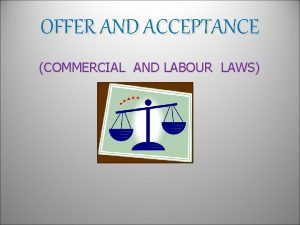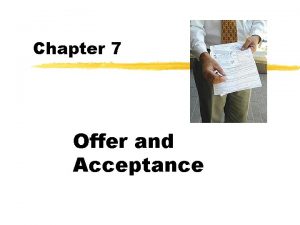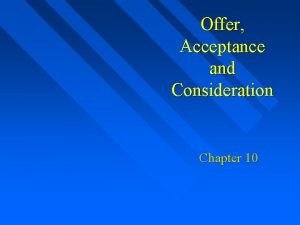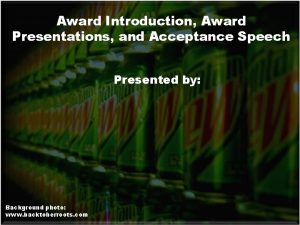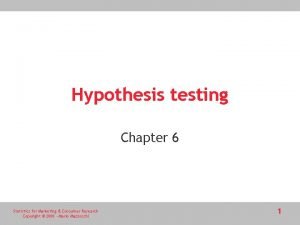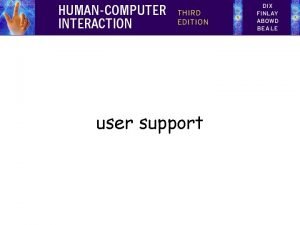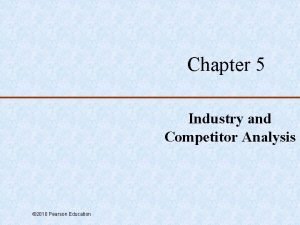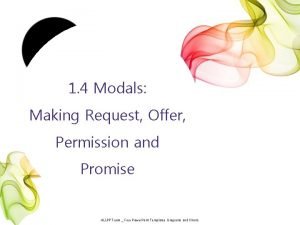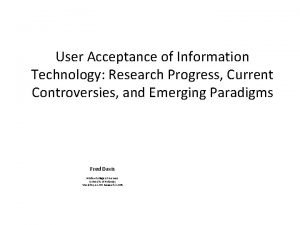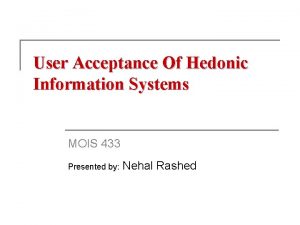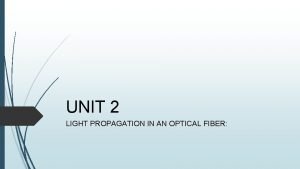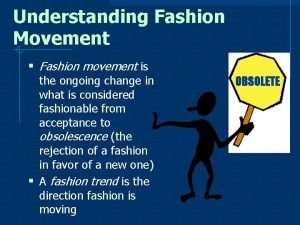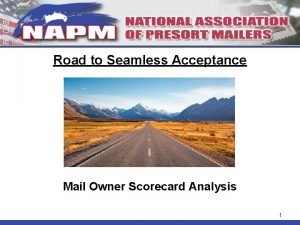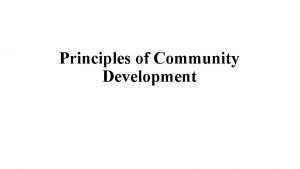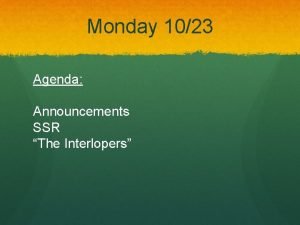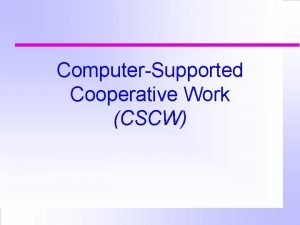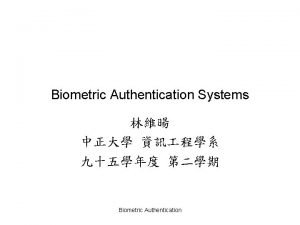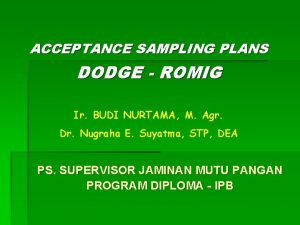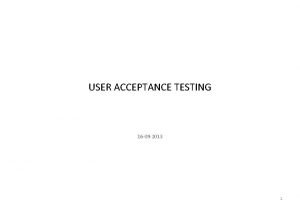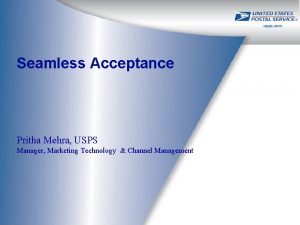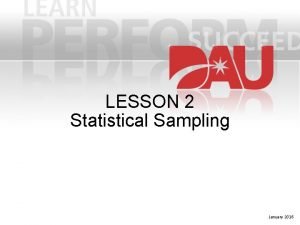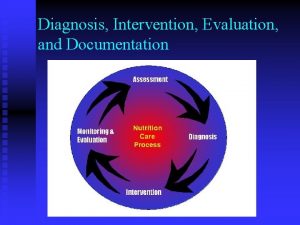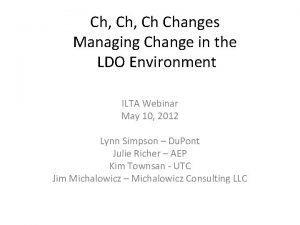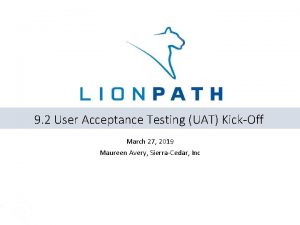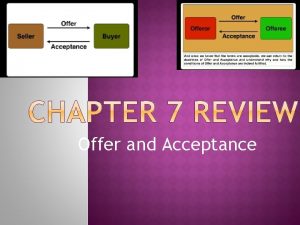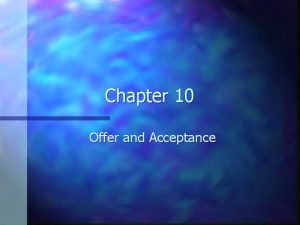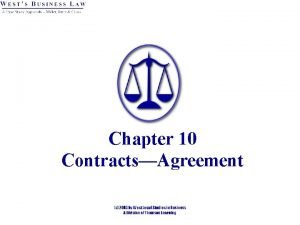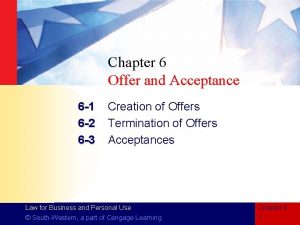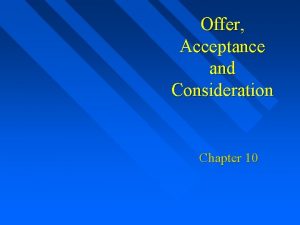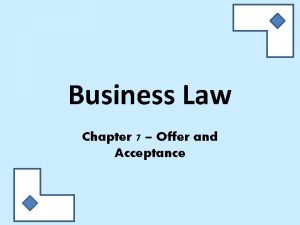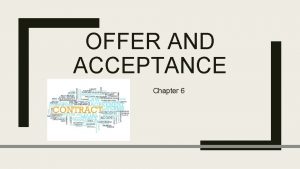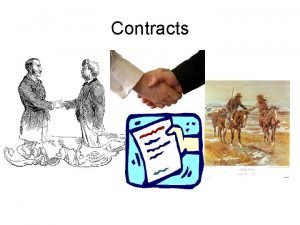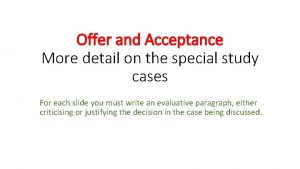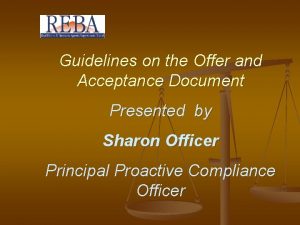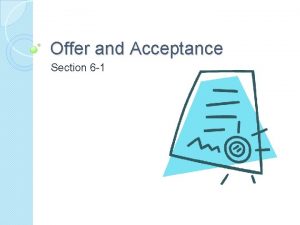CHAPTER 6 Offer and Acceptance 6 1 6















































- Slides: 47

CHAPTER 6 Offer and Acceptance 6 -1 6 -2 6 -3 Creation of Offers Termination of Offers Acceptances LAW for Business and Personal Use © 2012 Cengage Learning. All Rights Reserved. May not be scanned, copied or duplicated, or posted to a publicly accessible website, in whole or in part.

6 -1 Creation of Offers n GOALS n List the elements required to form a contract n Describe the requirements of an offer LAW for Business and Personal Use Chapter 6 © 2012 Cengage Learning. All Rights Reserved. May not be scanned, copied or duplicated, or posted to a publicly accessible website, in whole or in part. SLIDE 2

n https: //www. youtube. com/watch? v=HPYz 2 Iz. I ii 0&feature=player_detailpage n https: //www. youtube. com/watch? v=WWWBZ 4 x. D 7 Rg&feature=player_detailpage LAW for Business and Personal Use Chapter 6 © 2012 Cengage Learning. All Rights Reserved. May not be scanned, copied or duplicated, or posted to a publicly accessible website, in whole or in part. SLIDE 3

REQUIREMENTS OF A LEGALLY ENFORCEABLE CONTRACT n n n Offer and acceptance Genuine assent Legality Consideration Capacity Proper form LAW for Business and Personal Use Chapter 6 © 2012 Cengage Learning. All Rights Reserved. May not be scanned, copied or duplicated, or posted to a publicly accessible website, in whole or in part. SLIDE 4

NATURE AND CLASSES OF CONTRACTS n Executed and executory contracts n Express, implied-in-fact, and implied-at-law (quasi) contracts n Unilateral and bilateral (multilateral) contracts LAW for Business and Personal Use Chapter 6 © 2012 Cengage Learning. All Rights Reserved. May not be scanned, copied or duplicated, or posted to a publicly accessible website, in whole or in part. SLIDE 5

What is a contract? n https: //www. youtube. com/watch? v=Ca. J 4 Ay 1 Ky. MU&feature=player_detailpage n https: //www. youtube. com/watch? v=q. Y 1 M 7 os ZSvw&feature=player_detailpage LAW for Business and Personal Use Chapter 6 © 2012 Cengage Learning. All Rights Reserved. May not be scanned, copied or duplicated, or posted to a publicly accessible website, in whole or in part. SLIDE 6

Implied in fact and Quasi Contracts n http: //study. com/academy/lesson/expressedvs-implied-contracts-differencesexamples. html LAW for Business and Personal Use Chapter 6 © 2012 Cengage Learning. All Rights Reserved. May not be scanned, copied or duplicated, or posted to a publicly accessible website, in whole or in part. SLIDE 7

CHECKPOINT n What elements are required to form a legally enforceable contract? LAW for Business and Personal Use Chapter 6 © 2012 Cengage Learning. All Rights Reserved. May not be scanned, copied or duplicated, or posted to a publicly accessible website, in whole or in part. SLIDE 8

REQUIREMENTS OF AN OFFER n Contractual intent must be present n n Jests Statements made in anger or terror Preliminary negotiations Social agreements n Offer must be communicated to the offeree n Essential terms must be complete and definite LAW for Business and Personal Use Chapter 6 © 2012 Cengage Learning. All Rights Reserved. May not be scanned, copied or duplicated, or posted to a publicly accessible website, in whole or in part. SLIDE 9

CHECKPOINT n What are the requirements of an offer? LAW for Business and Personal Use Chapter 6 © 2012 Cengage Learning. All Rights Reserved. May not be scanned, copied or duplicated, or posted to a publicly accessible website, in whole or in part. SLIDE 10

6 -2 Termination of Offers n GOALS n Describe the various ways to end offers n Explain how an offeree can ensure an offer will remain open LAW for Business and Personal Use Chapter 6 © 2012 Cengage Learning. All Rights Reserved. May not be scanned, copied or duplicated, or posted to a publicly accessible website, in whole or in part. SLIDE 11

HOW CAN OFFERS BE ENDED? n Revocation by the offeror n Revocation n Can be done by the offeror anytime before the offeree accepts the offer. n Promise to keep offer open is not legally binding. LAW for Business and Personal Use Chapter 6 © 2012 Cengage Learning. All Rights Reserved. May not be scanned, copied or duplicated, or posted to a publicly accessible website, in whole or in part. SLIDE 12

Time stated in offer n Offeror may state how and when the offer must be accepted. LAW for Business and Personal Use Chapter 6 © 2012 Cengage Learning. All Rights Reserved. May not be scanned, copied or duplicated, or posted to a publicly accessible website, in whole or in part. SLIDE 13

Reasonable length of time n Offer ends after a reasonable length of time when not specifically stated. n Reasonableness depends on the circumstances surrounding the offer n Set time table for acceptance of offer. LAW for Business and Personal Use Chapter 6 © 2012 Cengage Learning. All Rights Reserved. May not be scanned, copied or duplicated, or posted to a publicly accessible website, in whole or in part. SLIDE 14

Rejection by the Offeree n If the offeree rejects the offer, he cannot later try to accept. n If offeree approaches offeror to accept after rejecting, this is a new offer that the offeror either can accept or reject. LAW for Business and Personal Use Chapter 6 © 2012 Cengage Learning. All Rights Reserved. May not be scanned, copied or duplicated, or posted to a publicly accessible website, in whole or in part. SLIDE 15

Counteroffer n Offeree’s response to an offer which modifies the original offer. n Terminates the original offer and a new offer is made. LAW for Business and Personal Use Chapter 6 © 2012 Cengage Learning. All Rights Reserved. May not be scanned, copied or duplicated, or posted to a publicly accessible website, in whole or in part. SLIDE 16

Counteroffer Video n https: //www. youtube. com/watch? v=Gc_Ui. M Wx. Vb. M&feature=player_detailpage LAW for Business and Personal Use Chapter 6 © 2012 Cengage Learning. All Rights Reserved. May not be scanned, copied or duplicated, or posted to a publicly accessible website, in whole or in part. SLIDE 17

Death or insanity of Either the Offeror or Offeree n Both of these eliminate control over the contract. LAW for Business and Personal Use Chapter 6 © 2012 Cengage Learning. All Rights Reserved. May not be scanned, copied or duplicated, or posted to a publicly accessible website, in whole or in part. SLIDE 18

Destruction of the Specific Subject Matter n If the offer relates to something specific and that item is destroyed, the offer is terminated LAW for Business and Personal Use Chapter 6 © 2012 Cengage Learning. All Rights Reserved. May not be scanned, copied or duplicated, or posted to a publicly accessible website, in whole or in part. SLIDE 19

CHECKPOINT n Explain two ways in which offers can be terminated. LAW for Business and Personal Use Chapter 6 © 2012 Cengage Learning. All Rights Reserved. May not be scanned, copied or duplicated, or posted to a publicly accessible website, in whole or in part. SLIDE 20

HOW CAN AN OFFER BE KEPT OPEN? n Options n Separate contract arising when the offeree gives the offeror something of value in return for a promise to leave an offer open. n Mailbox rule; proper dispatch n https: //www. youtube. com/watch? feature=player_ detailpage&v=l_4 BKm 2 uh. SI LAW for Business and Personal Use Chapter 6 © 2012 Cengage Learning. All Rights Reserved. May not be scanned, copied or duplicated, or posted to a publicly accessible website, in whole or in part. SLIDE 21

HOW CAN AN OFFER BE KEPT OPEN? n Firm offers n Applies to merchants who make offers in writing. n A proposal in writing made by a merchant stating how long the offer is to stay open LAW for Business and Personal Use Chapter 6 © 2012 Cengage Learning. All Rights Reserved. May not be scanned, copied or duplicated, or posted to a publicly accessible website, in whole or in part. SLIDE 22

Firm offers n § 2 -205. Firm Offers An offer by a merchant to buy or sell goods in a signed writing which by its terms gives assurance that it will be held open is not revocable, for lack of consideration, during the time stated or if no time is stated for a reasonable time, but in no event may such period of irrevocability exceed three months; but any such term of assurance on a form supplied by the offeree must be separately signed by the offeror LAW for Business and Personal Use Chapter 6 © 2012 Cengage Learning. All Rights Reserved. May not be scanned, copied or duplicated, or posted to a publicly accessible website, in whole or in part. SLIDE 23

CHECKPOINT n How could an offeree ensure that an offer will stay open for a set period of time? LAW for Business and Personal Use Chapter 6 © 2012 Cengage Learning. All Rights Reserved. May not be scanned, copied or duplicated, or posted to a publicly accessible website, in whole or in part. SLIDE 24

6 -3 Acceptances n GOALS n Discuss the requirements of an effective acceptance n Determine at what point in time an acceptance is effective LAW for Business and Personal Use Chapter 6 © 2012 Cengage Learning. All Rights Reserved. May not be scanned, copied or duplicated, or posted to a publicly accessible website, in whole or in part. SLIDE 25

WHAT IS REQUIRED OF AN ACCEPTANCE? n Only offerees may accept n The acceptance must match the offer n Acceptance must be communicated to the offeror n n n Silence as acceptance Promises as acceptance Performance as acceptance Modes of contractual communication When acceptances are effective LAW for Business and Personal Use Chapter 6 © 2012 Cengage Learning. All Rights Reserved. May not be scanned, copied or duplicated, or posted to a publicly accessible website, in whole or in part. SLIDE 26

Only Offeree May Accept n Offer made to one person must be accepted by that person n Made to the general public or a group n Any member who knows of the offer may accept LAW for Business and Personal Use Chapter 6 © 2012 Cengage Learning. All Rights Reserved. May not be scanned, copied or duplicated, or posted to a publicly accessible website, in whole or in part. SLIDE 27

Acceptance must be mirror image n Must exactly match the terms contained in the offer. n Including how the acceptance is made. n Normally only applied when the term altered is considered to be “material” and related to providing service or sale of real estate. LAW for Business and Personal Use Chapter 6 © 2012 Cengage Learning. All Rights Reserved. May not be scanned, copied or duplicated, or posted to a publicly accessible website, in whole or in part. SLIDE 28

Contracts: What is the Mirror Image Rule? n https: //www. youtube. com/watch? feature=pla yer_detailpage&v=ama 0 ep. Dkt 6 c LAW for Business and Personal Use Chapter 6 © 2012 Cengage Learning. All Rights Reserved. May not be scanned, copied or duplicated, or posted to a publicly accessible website, in whole or in part. SLIDE 29

What is the Uniform Commercial Code? n https: //www. youtube. com/watch? feature=pla yer_detailpage&v=ew. P_Qiin. J_g LAW for Business and Personal Use Chapter 6 © 2012 Cengage Learning. All Rights Reserved. May not be scanned, copied or duplicated, or posted to a publicly accessible website, in whole or in part. SLIDE 30

Uniform Commercial Code: Changes to Mirror Image Rule n https: //www. youtube. com/watch? feature=pla yer_detailpage&v=ZG 9 cyqlu. C 54 n Are the two parties merchants or not? LAW for Business and Personal Use Chapter 6 © 2012 Cengage Learning. All Rights Reserved. May not be scanned, copied or duplicated, or posted to a publicly accessible website, in whole or in part. SLIDE 31

Uniform Commercial Code n If the two parties to the contract are merchants: n Additional terms are proposals that become part of the contract between merchants unless………… n The offer says the offeree CANNOT add terms n The additional terms materially alter the contract n The offeror objects LAW for Business and Personal Use Chapter 6 © 2012 Cengage Learning. All Rights Reserved. May not be scanned, copied or duplicated, or posted to a publicly accessible website, in whole or in part. SLIDE 32

Uniform Commercial Code: Changes to Mirror Image Rule n https: //www. youtube. com/watch? feature=pla yer_detailpage&v=44 Hlgjy. QSV 8 LAW for Business and Personal Use Chapter 6 © 2012 Cengage Learning. All Rights Reserved. May not be scanned, copied or duplicated, or posted to a publicly accessible website, in whole or in part. SLIDE 33

One of three approaches to dealing with changes n Knockout rule n Contradictory terms are “knocked out” of the contract n Use the UCC to fill in for the contradictory terms LAW for Business and Personal Use Chapter 6 © 2012 Cengage Learning. All Rights Reserved. May not be scanned, copied or duplicated, or posted to a publicly accessible website, in whole or in part. SLIDE 34

n If both parties are merchants, the new terms are not part of the contract n If the offeror objects or n If the terms are material n If both parties are merchants, the new terms are considered part of the contract if the offeror is silent about the changes and the terms are not material. LAW for Business and Personal Use Chapter 6 © 2012 Cengage Learning. All Rights Reserved. May not be scanned, copied or duplicated, or posted to a publicly accessible website, in whole or in part. SLIDE 35

Acceptance Must Be Communicated to the Offeror n 1 Silence as acceptance: DOES NOT WORK!!! n 2 Promises as acceptance: can give a promise instead of performing the contracted act. This for that (bilateral contracts) n 3 Performance as acceptance: Unilateral contract. If one performs the act, the contract is valid (finding a lost dog) LAW for Business and Personal Use Chapter 6 © 2012 Cengage Learning. All Rights Reserved. May not be scanned, copied or duplicated, or posted to a publicly accessible website, in whole or in part. SLIDE 36

n 4. Modes of contractual acceptance n “may be made by telephone, fax, email, text, mail, delivery service. ” n UCC: acceptance of offer may be made in any manner and by any medium reasonable in the circumstances unless otherwise clearly indicated by the language of the circumstances. n A set of principles that the UCC attempted to put into law to cover contracting by computer was overwhelmingly turned down by the states. LAW for Business and Personal Use Chapter 6 © 2012 Cengage Learning. All Rights Reserved. May not be scanned, copied or duplicated, or posted to a publicly accessible website, in whole or in part. SLIDE 37

When acceptances are effective n All forms of contractual communications take effect when received EXCEPT FOR: n Acceptance! n Effective when sent. LAW for Business and Personal Use Chapter 6 © 2012 Cengage Learning. All Rights Reserved. May not be scanned, copied or duplicated, or posted to a publicly accessible website, in whole or in part. SLIDE 38

n Use the “customary” method for that type of acceptance: n Stock market uses hand signals n Next-day delivery n When customary service is used, the acceptance is effective when sent unless the contract states otherwise. LAW for Business and Personal Use Chapter 6 © 2012 Cengage Learning. All Rights Reserved. May not be scanned, copied or duplicated, or posted to a publicly accessible website, in whole or in part. SLIDE 39

What if there is no specified or customary method? n Use the same method used by the offer. n UCC: If the acceptance of an offer for the sale or purchase of goods is sent by “reasonable” means, it is effective when sent. LAW for Business and Personal Use Chapter 6 © 2012 Cengage Learning. All Rights Reserved. May not be scanned, copied or duplicated, or posted to a publicly accessible website, in whole or in part. SLIDE 40

Questions: n When is an oral acceptance effective? n When spoken directly to the offerer n When is a posted or telegraphed acceptance effective? n When it is irretrievably separated from the offeree by it being placed in a mail box or given to a clerk to send LAW for Business and Personal Use Chapter 6 © 2012 Cengage Learning. All Rights Reserved. May not be scanned, copied or duplicated, or posted to a publicly accessible website, in whole or in part. SLIDE 41

Questions: n When is an acceptance by fax effective? n Immediately upon being sent n _____ occurs when a party to whom an offer has been made agrees to the proposal. n True or false: If an offeror specifies in the offer that the acceptance must be made by fax, an e-mailed acceptance will not be effective. n True LAW for Business and Personal Use Chapter 6 © 2012 Cengage Learning. All Rights Reserved. May not be scanned, copied or duplicated, or posted to a publicly accessible website, in whole or in part. SLIDE 42

Questions: n True or False: All forms of acceptance take effect only when received. n False n If the parties to a contract have mutual obligations to perform it, the contract is termed n A. unilateral n B bilateral n Neither of these LAW for Business and Personal Use Chapter 6 © 2012 Cengage Learning. All Rights Reserved. May not be scanned, copied or duplicated, or posted to a publicly accessible website, in whole or in part. SLIDE 43

Questions n True or False: When there is no specified or customary means for communicating acceptances, a faster means than that employed by the offeror to make the offer would be considered effective by the courts n True LAW for Business and Personal Use Chapter 6 © 2012 Cengage Learning. All Rights Reserved. May not be scanned, copied or duplicated, or posted to a publicly accessible website, in whole or in part. SLIDE 44

CHECKPOINT n What are the requirements of an effective acceptance? LAW for Business and Personal Use Chapter 6 © 2012 Cengage Learning. All Rights Reserved. May not be scanned, copied or duplicated, or posted to a publicly accessible website, in whole or in part. SLIDE 45

PREVENT LEGAL DIFFICULTIES n When you seek to enter into a contract. . . n When negotiating, assume the worst and include terms in the contract addressing potential problems. n For important contracts, put offers and acceptances in writing. If either an offer or an acceptance is made orally, promptly confirm it in writing. n Obtain and keep a copy of every important document you sign. n Express your intentions in offers and acceptances with clear, complete, and understandable language. Continued on the next slide LAW for Business and Personal Use Chapter 6 © 2012 Cengage Learning. All Rights Reserved. May not be scanned, copied or duplicated, or posted to a publicly accessible website, in whole or in part. SLIDE 46

PREVENT LEGAL DIFFICULTIES n Remember that the offeror may specify how and when the offer must be accepted. Otherwise the offeree may use the same means used by the offeror, a faster means, or other reasonable means. n When appropriate, buy an option, if one is available, to keep the offer open for as long as you need. n Remember that for an offeror to withdraw or revoke an offer, the offeree must receive notice. For speed, use the telephone, e-mail, or fax machine to withdraw or revoke an offer. LAW for Business and Personal Use Chapter 6 © 2012 Cengage Learning. All Rights Reserved. May not be scanned, copied or duplicated, or posted to a publicly accessible website, in whole or in part. SLIDE 47
 Offer and acceptance
Offer and acceptance Offer and acceptance
Offer and acceptance Contract offer acceptance consideration
Contract offer acceptance consideration Sip early offer vs delayed offer
Sip early offer vs delayed offer Discount houses in india
Discount houses in india Direct procurement
Direct procurement Childhood sensuality circle
Childhood sensuality circle Non-marketer dominated stimuli
Non-marketer dominated stimuli Awards presentation speech
Awards presentation speech And acceptance is the answer to all my problems
And acceptance is the answer to all my problems Acceptance and rejection region
Acceptance and rejection region Gaze visual literacy
Gaze visual literacy What are the 4 main types of assistance that users require?
What are the 4 main types of assistance that users require? Pearson education competitors
Pearson education competitors Modals of permission request and offer
Modals of permission request and offer Example suggestion and offering
Example suggestion and offering Tams ut austin
Tams ut austin Usmaps acceptance rate
Usmaps acceptance rate User acceptance of information technology
User acceptance of information technology User acceptance of hedonic information systems
User acceptance of hedonic information systems Numerical aperture optical fiber
Numerical aperture optical fiber Flop fashion cycle examples
Flop fashion cycle examples Ucla school of nursing acceptance rate
Ucla school of nursing acceptance rate Ubc nursing admission
Ubc nursing admission Seamless acceptance scorecard software
Seamless acceptance scorecard software Principles of acceptance
Principles of acceptance Analytical paragraph
Analytical paragraph Documentary sale
Documentary sale Goal and ambition
Goal and ambition Goal acceptance
Goal acceptance Tolerance vs acceptance
Tolerance vs acceptance What is cscw
What is cscw False acceptance rate
False acceptance rate Thomas j watson school of engineering acceptance rate
Thomas j watson school of engineering acceptance rate Tabel dodge romig
Tabel dodge romig Uat preparation
Uat preparation Seamless acceptance
Seamless acceptance The final aim of negotiation is to
The final aim of negotiation is to Zero based sampling plan
Zero based sampling plan A formal reply is written in-
A formal reply is written in- Seoul university acceptance rate
Seoul university acceptance rate Address personal letter
Address personal letter York u myfile
York u myfile Pes statement nutrition
Pes statement nutrition Acceptance definition
Acceptance definition Change curve+awareness+understanding+acceptance+commitment
Change curve+awareness+understanding+acceptance+commitment Fit acceptance
Fit acceptance Uat presentation
Uat presentation
